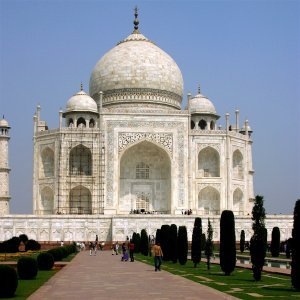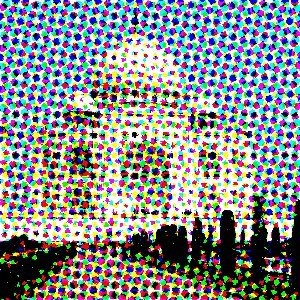| 4.10. Газетная бумага | ||
|---|---|---|
 |
4. Фильтр искажения |  |
Рисунок 16.57. Пример применения фильтра «Газетная бумага»

Исходное изображение

После применения фильтра «Газетная бумага»
Этот фильтр преобразует изображение в полутоновые точки, чтобы добиться эффекта газетной печати. Полутонирование - создание изображения со многими уровнями серого или цвета (т.е. слитный тон) на аппарате с меньшим количеством тонов, обычно чёрно-белый принтер.
В принципе, задача в том чтобы уменьшить разрешение, увеличивая видимую глубину тона (так называемое пространственное полутонирование).
Существуют много путей достижения эффекта. Простейший заключается в выбрасывании нижние биты тоновой информации; это делается фильтром «Постеризовать». Результат выглядит неважно, но пространственное разрешение не потеряно.
Этот фильтр использует полутонирование сгрупированными точками. Это уменьшает разрешение изображения за счёт преобразования ячеек в капли, которые уменьшаются или увеличиваются в зависимости от того, какой цвет нужно передать.
Представте сетку, наложенную на начальное изображение. Изображение разделено сеткой на ячейки, каждая из которых будет содержать одну каплю, состоящее из группы точек. Интенсивность точек выбирается так, чтобы приблизить результат к темноте ячейки начального изображения.
Obviously, a large cell size results in a heavy loss in resolution! The spots in the cells typically start off as circles, and grow to be diamond shaped. This change in shape is controlled by a Spot function. By using different spot functions, the evolution in the shape of the spots as the cell goes from fully black to fully white may be controlled.
All your setting changes will appear in the Preview without affecting the image until you click on OK. Note that the preview displays only a part of the whole image if the filter is applied to an selection. Don't keep Preview checked if your computer is too slow.
Эта группа определяет размер ячейки, либо задавая вводное или выходное разрешение, либо напрямую.
Resolution of the original input image, in Samples Per Inch (SPI). This is automatically initialised to the input image's resolution.
Desired output resolution, in Lines Per Inch (LPI).
Resulting cell size, in pixels. Most often you will want to set this directly.
Select which colorspace you wish to operate in. In RGB mode, no colorspace conversion is performed. In CMYK, the image is first internally converted to CMYK, then each color channel is separately halftoned, before finally being recombined back to an RGB image. In Intensity mode, the image is internally converted to grayscale, halftoned, then the result used as the alpha channel for the input image. This is good for special effects, but requires a little experimentation to achieve best results. Hint: try CMYK if you don't know which to go for initially.
When doing RGB->CMYK conversion, how much K (black) should be used?
Make channel modifications apply to all channels.
Restore the default settings which should give pleasing results.
Cell grid angle for this channel.
Spot function to be used for this channel (see preview in blue cell-boxes).
Правильное полутонирование не нуждается в сглаживании: задача-то уменьшить глубину цвета. Однако, поскольку этот фильтр используется в основном для спец-эффектов, результат обычно показан на экране, а не на чёрно-белом принтере. Поэтому полезно применить немного сглаживания, чтобы имитировать расрлывшиеся чернила на бумаге. Значение 1 отключает сглаживание, что хорошо для отпечатки.
Number of subpixels to sample to produce each output pixel. Set to 1 to disable this feature. Warning: large numbers here will lead to very long filter runtimes!